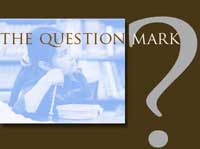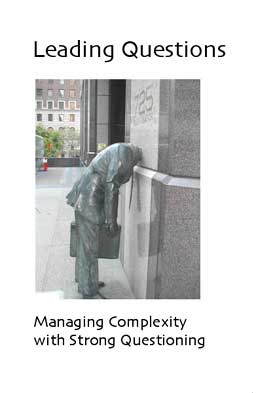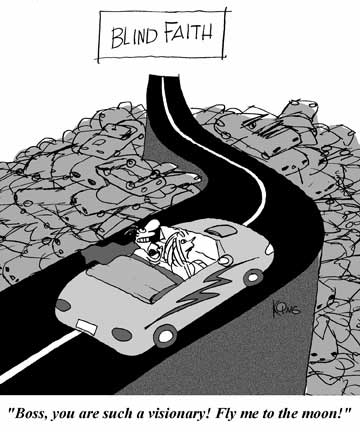1. Good Doubt and Bad Doubt.
Good doubt is questioning that springs from a positive spirit - a constructive skepticism that wonders about risks and pitfalls out of a wish for the enterprise to succeed.
Bad doubt is questioning that springs from a negative spirit - a destructive skepticism that dwells on issues and problems with the hope that the whole project will come tumbling down.
Proponents of blind faith tend to portray all doubt as evil. They point to the biblical story of a Doubting Thomas who had the audacity to ask for evidence that Jesus rose from the dead. They make doubt seem disloyal, corrosive and possibly unpatriotic. They lump all doubt into the same category. Doubt is sin and doubters should be replaced by true believers. Doubt is heresy. Doubters are heretics.
2. The Leader as Visionary without a Doubt
We suffer from decades of management gurus and their books pushing the wonders of visionary leaders - inspired folk who can somehow find the way for the rest of us mortals because of superior intellect, instincts, intuition or heavenly connections. These leaders have great gut feelings that are expected to transcend rational analysis.
Those who claim a direct chatting connection to God are among the most dangerous of leaders. If God is sending in the plays, why take time to consult with mere mortals? If a leader is having visions, perhaps we should wonder what they have been smoking, drinking, popping or injecting?
Visionary leaders are usually intolerant of doubt and doubters. They prefer worship to doubt. Because they are usually in a hurry to translate dreams into reality, visionary leaders are often ill-disposed to any discussion that might slow down their dash to glory.
3. Constructive Criticism and Plan Review
Good thinkers welcome constructive criticism as they develop and launch plans with their teams. Goals, strategies and tactics should all be subjected to intense review. All members of the team are trained in such critical thinking and their strengths in this domain are recognized formally as part of the performance review.
Team members learn to ask questions like the following as the plan passes through the stages of development:
- Do we have the right goals?
- Have we identified the critical factors influencing this situation or have we fallen into the trap of addressing symptoms rather than root causes?
- Has our problem identification process been comprehensive?
- What is still missing?
- Who else should we consult who might guide us well?
- Is the action plan well grounded in past practice while forward-looking and innovative?
- Have we learned of and from the mistakes of others?
- What could possibly go wrong?
- What's the worst that might happen?
- What obstacles, barriers and surprises might block our success?
- What can we do to prepare for them?
4. De-Commissioning the Auto-Pilot
"Damn the torpedoes, full speed ahead!"
The historical context for this quotation attributed to Admiral David G. Farragut was the Battle of Mobile Bay. The Confederates had deployed mines (called torpedoes then) throughout the Bay. When the Union fleet faltered at one point, he was credited with rallying them on through the floating mines to victory.
The Farragut model of leadership may work in an occasional battle or two, but it is hardly a smart way to run an organization.
- "Damn the facts, full speed ahead!"
- "Damn the casualties, full speed ahead!"
- "Damn the critics, full speed ahead!"
- "Damn the deficit, full speed ahead!"
- "Damn the accountants, full speed ahead!"
Visionaries are often guilty of putting the organization on autopilot. Sure of their visions and confident in their plans, they speed along even into uncharted seas with the steering locked in place. They ignore the mines, the warnings and the clues that something is amiss. Suicidal behavior for all on board.
Such leaders are too often glorified for their guts and staying power, as if stubborn determination combined with denial were proof of manhood or womanhood.
"Boy that sure took guts!"
Swagger trumps rational decision-making.
Because plans of action must almost always be modified in the light of day when theory meets reality, teams must subject them to continual review and revision, adjusting strategies to match real conditions.
Unfortunately, visionaries and faith-based leaders are usually unwilling to entertain such alterations, seeing them as threats to their authority and a form of rebuke. No matter how bad the storm or the number of folks dying in hopsital beds, the plan is working well.
- "You're either with me or against me."
- ". . . and, Brownie, you're doing a heck of a job."
As this book was being written, President Bush created the semblance of a plan review for Iraq, orchestrating a blend of the Baker Study Commission with a parade of visitors meant to create a new strategy, but when all was said and done, there was nothing new about his announcement of more troops. More of the same wrong-minded disastrous military intervention. Blind faith in the face of facts. "Victory is still possible!"
5. Doubt as Preventive Medicine
When good doubt is elevated to prominence and when questioning is encouraged, the organization is more likely to flourish in changing or tumultuous times than organizations that cling unquestioningly to prescriptions and visions.
The efforts of the Bill and Melinda Gates Foundation to change the nature of American schools with their Small Schools Project is an example of a notion that becomes faith.
Sadly, huge organizations funded by this century's robber barons can wield enormous influence on public institutions in ways that are often wrong-minded and undemocratically guided. Simple wealth has become sufficient excuse to wade in with big bucks and try out experiments poorly grounded in research and hastily implemented in the rush to dispense funds within federal time guidelines governing foundations. Rather than launching small pilots that can be scaled up after the model has been tested and refined, a foundation may skip the preliminaries.
"Small schools are better!"
The Gates Foundation poured millions into a program to encourage the development of small high schools, basing their strategy on presumptions like the following:
- In schools with fewer than 600 youngsters, we now know, students generally learn better, drop out less, and attend more. They participate in extracurricular activities in greater numbers and get into fewer disciplinary difficulties. On college-related variables—entrance examination scores, acceptance rates, grade point averages—students from small high schools match or exceed those from large ones.
-
- And small schools work especially well for the least advantaged students. Studies linking school size, poverty, and student achievement indicate larger schools, particularly urban ones, exacerbate the negative effects of poverty on student learning.
Announced in 2000, the program has met with little dramatic success and many disappointments according to various reports, reviews and studies.
A simple minded reform notion (small = better) was elevated to the status of religion and funded generously. Bypassing significant aspects of quality education and relying upon short term, temporary infusions of extraordinary resources, the project disrupted the lives of many schools, teachers and students so as to play out the reform fantasies of a foundation.
One columnist, Diane Ravitch, somewhat sardonically referred to Bill Gates as the "the Nation's Superintendent of Schools" in a July, 2006 column questioning the value of the Small Schools Project as implemented.
She mentions that math results in the small schools are below the large schools and that some districts like Denver have been backing away from the model because it offers limited choices to students.
- In light of its experiences, the Gates Foundation seems chastened and apparently has recognized that curriculum (what students are taught) and instruction (the quality of teachers) may be no less important than school size.
In 2005, Education Week ran an article, "Gates High Schools Get Mixed Review in Study"
http://www.edweek.org/ew/articles/2005/11/16/12gates.h25.html\ In this article they quoted findings of a research group charged with evaluating the smaller schools project. (Full study available in PDF here.)
- "[W]e concluded that the quality of student work in all of the schools we studied is alarmingly low,” the evaluation says. “This is not surprising, however, because students cannot demonstrate high-quality work if they have not been given assignments that require … deep understanding” and higher-order thinking skills.
As is often the case when large organizations get information that challenges the value of what they are doing, the Gates Foundation called a halt to that study, making various excuses to explain their new more secretive approach to project evaluation.
Education Week also ran an article describing this shift in evaluation strategy.
"Foundation Shifts Tack on Studies
Scholars say Gates risks losing valuable findings."
By Debra Viadero
Education Week
October 25, 2006
http://www.edweek.org/ew/articles/2006/10/25/09gates.h26.html
- “The evaluation appears to have led Gates to think we don’t need to learn any more about this approach of focusing on school size per se,” said Michael W. Kirst, a professor of education at Stanford University. “But there’s never been anything like this of this size and scale outside of government funding, and we owe it to future reformers to come back and finish this.”
Other observers have suggested that the Gates approach to school reform has stepped into systems with a large footprint, creating damage in the way it disrupts the systems while reshuffling students and programs.
In a January 25, 2006 Commentary: "Come Clean on Small Schools," David C. Bloomfield writing in Education Week is quite harsh in his criticism.
http://www.edweek.org/ew/articles/2006/01/25/20bloomfield.h25.html
- The results in those schools are mixed at best, and fail to tell the story of whole systems—hundreds of thousands of students—disrupted by this ill-planned venture.
-
- But without adequate quality controls, these schools can be just as mediocre as the average large school, and can cause severe disruption to students in other schools. In a study by Policy Research Associates, funded by the Gates Foundation, New York City public schools in the first two years of the New Century High Schools initiative were generally found to be cherry-picking students and teachers, to have failed to innovate instructionally, to lack promised community partnerships, to have declining levels of discipline, and to show no improvement in student achievement. The New York Times divulged these secret findings after the report was bottled up by a not-for-profit group that acts as a conduit for the Gates funds. The reason, the Times reported, was that officials responsible for the initiative “questioned some of the findings” and wanted to “interview” partners and principals about their responses to researchers’ questions.
-
- None of these statistics finds its way into the small-schools literature generated by funders. To the degree that mistakes are admitted, there is a strangely dispassionate tone, as if the children harmed are little more than lab mice. Education Week reports that as a result of negative research findings, Tom Vander Ark, who heads the Gates schools initiative, says the foundation is now “shifting its grantmaking approach.” Moving on.
Driven by faith in a simple idea, the project churns on. When evaluation data challenges the wisdom of the vision, the data collection is revised. It is much like the fairy tale of the wicked queen who broke the mirror when it failed to report that she was the fairest of the all.
6. Doubt as a Bad Word
Curiously, the culture has treated doubt as a predominately bad state of mind or action, with many a dictionary and thesaurus offering mostly negative meanings and synonyms.
The Visual Thesaurus (http://visualthesaurus.com) offers the following cluster of related words:
- mistrust, suspect, distrust, uncertainty, incertitude, dubiety, dubiousness, doubtfulness, question, discredit, disbelieve
There is no mention here of the positive aspects of this doubt thought process.
In a similar fashion, the Oxford American Dictionaries provide the following definition: "a feeling of uncertainty or lack of conviction." Uncertainty is viewed as a weakness. Synonyms for doubt include "distrust, mistrust, doubtfulness, suspicion, cynicism, uneasiness, apprehension, wariness, chariness, leeriness; reservations, misgivings, suspicions."
In contrast to doubt, certainty is usually portrayed positively. The Oxford American Dictionaries provide the following synonyms: "confidence, sureness, positiveness, conviction, certitude, assurance."
It is difficult to find definitions of certainty that call it a form of blindness or closed-mindedness.
The Visual Thesaurus offers no synonyms for closed mindedness.
Roget's New Millennium™ Thesaurus offers the following synonyms for certainty:
- authoritativeness, belief, certitude, cinch, confidence, conviction, credence, definiteness, dogmatism, faith, firmness, indubitableness, inevitability, lock*, lockup*, positiveness, positivism, setup, shoo-in*, staunchness, steadiness, stock, store, sure bet*, sure thing*, surefire*, sureness, surety, trust, validity, wrap-up.
In an age of considerable uncertainty, it is important to note the cultural preference for assurance and firmness. There is too little support for the kind of questioning that would support the management of ambiguity, paradox, surprise and unthinkable developments.
A rigid hand on the steering wheel is evidently preferred over a wandering or wondering eye, the focus of the next chapter.
Encarta even goes so far as to lump together the words " foregone conclusion, safe bet, cert, cast-iron certainty, inevitability, confidence, conviction, faith, belief, assurance, firmness, sureness, certitude."
When certainty is just a state of mind, the leader must not confuse it with the truth, but in many cases leaders mistake the two as identical twins.
Jennifer Michael Hecht has written a history of doubt.
- In a sweeping history, Jennifer Michael Hecht celebrates doubt as an engine of creativity and as an alternative to the political and intellectual dangers of certainty. Just as belief has its own history featuring people whose unique expressions of faith have forever changed the world, doubt has a vibrant story and tradition with its own saints, martyrs, and sages.
- According to Hecht, "Confucius, Socrates, St. Augustine, Galileo and Frederick Douglass were just a few of the innovators who left their mark on history by challenging conventional wisdom."
Uncertainty Quotations
“Uncertainty is the only certainty there is, and knowing how to live with insecurity is the only security.” John Allen Paulos
“The quest for certainty blocks the search for meaning. Uncertainty is the very condition to impel man to unfold his powers.” Erich Fromm
Uncertainty will always be part of the taking charge process.” Harold S. Geneen
"I am certain there is too much certainty in the world." Michael Crichton
"In these matters the only certainty is that nothing is certain." Pliny the Elder


 Each chapter of Leading Questions will include one or more cartoons as well as quotations from famous people.
Each chapter of Leading Questions will include one or more cartoons as well as quotations from famous people.